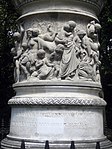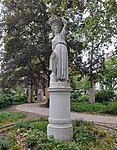Friedrich Drake



Friedrich Drake (born June 23, 1805 in Pyrmont , † April 6, 1882 in Berlin ; full name Johann Friedrich Drake ) was a German sculptor , a student of Christian Daniel Rauch and an excellent representative of the Berlin School of Sculpture . His best-known work is the Victoria on the Berlin Victory Column .
life and work
Friedrich Drake was the son of a mechanic, began an apprenticeship as a turner in Minden and then initially worked in his father's workshop. After he was called up for military service at the age of 22, he was saved from drafting by an unfamiliar advocate. In parallel to his craft, he had copied various foreign sculptures “for my entertainment”, “which received applause and sales.” A relative of Christian Daniel Rauch finally arranged for Drake to be able to take the picture in Rauch's studio in Berlin. He wrote:
"I began my studies in Professor Rauch's studio and at the same time took part in the modeling exercise based on the living model Theil at the Royal Academy of Arts, and after some time Professor Rauch also used me to help with his work."
A Madonna (1829, Drake's only religious work), a relief based on Goethe's 5th Elegy (1832) and his first major commission, “a colossal statue of Justus Möser for the city of Osnabrück” (erected in 1836) were created as own works . The fee enabled him to travel to Italy, which is mandatory for many German artists. With a letter of recommendation from Rauch, he visited the highly famous Danish colleague Bertel Thorwaldsen in Rome in 1836 , who is said to have praised Drake's Goethe relief (an engraving after).
Back in Berlin in 1837, he was appointed a member of the Academy of Arts , set up his own sculptor's workshop and brought his brothers Georg and Louis from Pyrmont , who served him as assistants, and his sister Karoline, who ran the household. When Karoline married the painter Eduard Meyerheim , Drake married Lisette Schönherr from Hamburg in 1843, with whom he had six children.
In 1847 Drake was appointed Royal Professor . From 1852 to 1866 his teaching activity at the Berlin Academy is attested. On May 31, 1863 he was accepted into the Prussian order Pour le Mérite for science and the arts, of which he became vice-chancellor on May 31, 1879. He presented the nude and, as a trained mechanic, invented a frame that made it easier for the nude model to hold its position.
The workshop was now fully occupied with numerous monument orders. For example, the Prussian King Friedrich Wilhelm IV ordered the statue of his father Friedrich Wilhelm III. , which was unveiled in Berlin's Tiergarten in 1849 and met with great approval. In 1855, on the 400th birthday of Philipp Melanchthon , the city of Wittenberg placed a memorial for Luther's companion next to the Luther sculpture by Johann Gottfried Schadow (from 1821) on its market square. And on July 4, 1876, on the centenary of the United States' Declaration of Independence, Drake's statue of the American researcher Alexander von Humboldt was unveiled in Philadelphia . In 1859 Drake entered into a second marriage with Countess Marie von Waldeck after his first wife had died after only twelve years of marriage.
In addition to the academy exhibitions, in which new works by Drake were regularly put up for discussion, national exhibitions were also sent with his sculptures: in 1851 and 1862 the world exhibitions in London, in 1855 and 1867 the world exhibitions in Paris and in 1858 and 1869 the international art exhibitions in Munich.
In 1873 the Berlin Victory Column was inaugurated . Drake had crowned it with a gilt bronze Victoria. However, the size ratio of Victoria and pillar immediately came under fire. The 8.32 meter tall gold else was felt to be too big and too clumsy for the 50.60 meter column. But even after the column was enlarged in 1939 by a further 7.50 m drum, the Berliner squealed :
“So this Victoria is not from Rauch. - No, because the Victory Column is also not a chimney. "
Work (selection)
- 1834: Drake's teacher Christian Daniel Rauch - Dresden, Albertinum ,
- 1835/36: Monument to Justus Möser - Osnabrück, Great Cathedral Freedom ,
- 1837–1845: two models for a Beethoven monument in Bonn, lost,
- 1841–1849: Monument to Friedrich Wilhelm III. - Berlin zoo near the Luiseninsel ,
- 1842: Grave monument made of Silesian marble for Bertha von der Schulenburg, b. von Jagow (1813–1835) in the village church of Rühstädt
- 1852–1855: Melanchthon monument - Wittenberg, market square; Models of the sandstone statues of the Electors Friedrich the Wise and Johann the Steadfast as well as for the music-making bronze boys on the Luther thesis portal of the Wittenberg Castle Church ,
- 1853: Figure groups Nike wreaths the winner made of Carrara marble - Berlin-Mitte, Schlossbrücke ,
- 1854–1860: Reliefs on the base of Rauch's Beuth monument - Berlin-Mitte, Schinkelplatz ,
- 1855–1859: Monument to Malte von Putbus - Putbus on Rügen,
- 1856–1858: Monument to the founder of the university, Johann Friedrich I , the "Magnanimous", on the occasion of the 300th anniversary of the university - Jena, market square,
- 1858: Vase with relief frieze Four people age , a gift to his native town of Bad Pyrmont (Altenauplatz)
- 1859–1867: Equestrian statue of Kaiser Wilhelm I - Hohenzollern Bridge in Cologne,
- 1860–1869: Schinkel Monument - Berlin-Mitte, Schinkel-Platz;
- 1864: Headpiece of the death mask of Countess Sophie Schwerin, b. Countess Dönhoff (1785–1863) in the memorial chapel of Dönhoffstädt Castle, Rastenburg district in East Prussia (still today, 2013, preserved);
- 1869–1872: Warrior memorial for Aachen, OURS IN THE WARS 1866.1870.1871. FALLEN SONS , destroyed,
- 1873: Viktoria on the Berlin Victory Column by Heinrich Strack - Berlin-Tiergarten, Großer Stern .
Grave of Friedrich Drake in the old St.-Matthäus-Kirchhof Berlin
Winegrower, 1854
Berlin-Wilmersdorf
Honors
- In 1850 he received the Order of the Red Eagle with Ribbon.
- In 1851 he was awarded the 2nd prize medal at the London World's Fair .
- In 1854 the Royal Prussian Academy of the Arts awarded him the small gold medal, followed by the large one in 1856.
- In 1856 an international jury in Paris awarded him the honorary diploma.
- 1858 after the establishment of the monument to John Frederick the Magnanimous gave him the Philosophical Faculty of the University of Jena , the honorary doctorate .
- In 1866, a street in the villa colony of Lichterfelde (today in the Steglitz-Zehlendorf district of Berlin) was named in his honor, the following year another street in Berlin-Tiergarten , and in 1920 another street in Berlin-Mahlsdorf .
- In 1867, after the death of Peter von Cornelius , he was Vice-Chancellor of the peace class of the order Pour le Mérite .
- In 1867 Napoleon III awarded him . , Emperor of the French, the Knight's Cross of the Legion of Honor .
- In 1870 he was awarded the Bavarian Maximilian Order for Science and Art .
- In 1870 he was accepted as a foreign member of the Académie des Beaux-Arts .
- 1909 Naming Drakestrasse and Drakeplatz in Düsseldorf- Oberkassel .
- His grave has been dedicated to the city of Berlin as an honorary grave since 1975 .
- In 2014 the Friedrich-Drake-Grundschule opened in the Berlin district of Lichterfelde in the Steglitz-Zehlendorf district.
literature
- Max Osborn: Drake, Friedrich . In: Allgemeine Deutsche Biographie (ADB). Volume 48, Duncker & Humblot, Leipzig 1904, pp. 70-73.
- Volkmar Essers: Johann Friedrich Drake 1805–1882. Munich 1976.
Web links
- Literature by and about Friedrich Drake in the catalog of the German National Library
Individual evidence
- ↑ Archive link ( Memento of the original from March 9, 2014 in the Internet Archive ) Info: The archive link was inserted automatically and has not yet been checked. Please check the original and archive link according to the instructions and then remove this notice.
- ↑ THE ORDER POUR LE MERITE FOR SCIENCE AND ARTS. The members of the order. Volume I. Gebr. Mann-Verlag, Berlin 1975, p. 232.
- ↑ Archive link ( Memento of the original from March 9, 2014 in the Internet Archive ) Info: The archive link was inserted automatically and has not yet been checked. Please check the original and archive link according to the instructions and then remove this notice.
- ↑ Berlin and its buildings , 1896, II./III. Building construction, page 42 (Ed. Vereinigg. Berliner Architekten, in several volumes) accessed January 18, 2020; u. a. such as B. City of Berlin
| personal data | |
|---|---|
| SURNAME | Drake, Friedrich |
| ALTERNATIVE NAMES | Drake, Johann Friedrich (full name) |
| BRIEF DESCRIPTION | German sculptor |
| DATE OF BIRTH | June 23, 1805 |
| PLACE OF BIRTH | Bad Pyrmont |
| DATE OF DEATH | April 6, 1882 |
| Place of death | Berlin |







